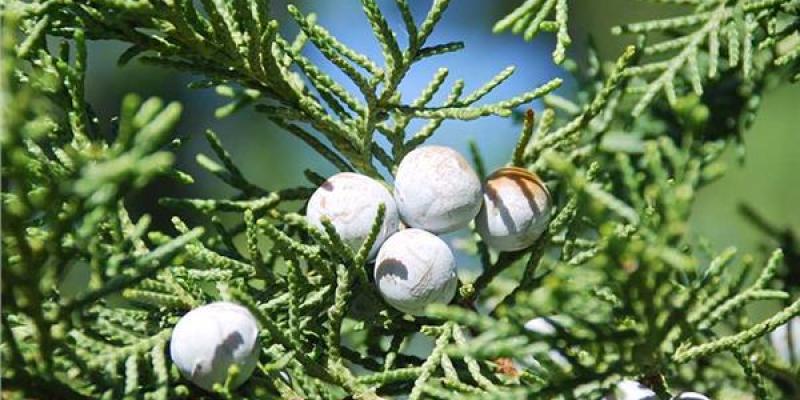EASTERN RED CEDAR MANAGEMENT

Eastern redcedar (Juniperus virginiana) is one of 13 juniper species native to the United States. It is the most widespread tree-sized conifer native to every state east of the 100th meridian. First accounts of Nebraska vegetation mention eastern redcedar as a native species, primarily along the steep valley of the Niobrara River in northern Nebraska, as a minor component in deciduous forests in eastern Nebraska, and as a dominant species on canyon sides in the rugged Loess Hills region of central Nebraska. Today, native stands of eastern redcedar can be found on most grasslands throughout central and eastern Nebraska and much of the Midwest.
Eastern redcedar is a problem in grassland biomes primarily because it reduces herbaceous forage production and diminishes the habitat needed for our native wildlife. Developing trees within or even adjacent to grasslands can alter the microclimate, which encourages a shift from desirable warm-season native grasses to introduced cool-season grasses such as Kentucky bluegrass. Grassland coverage and health usually depletes over time due to the exposure and overproduction of cedar tree seeds, seedling recruitment, and rapid encroachment, thus shading out grass even more. On many sites, complete coverage by eastern redcedar can be expected, resulting in a total loss of grass production unless controlled.
Integrated management has been commonly described as “a multi-disciplinary approach utilizing the application of numerous alternative control measures.” In other words, it means that developing a management plan needs to include the best combination of methods particular to the site being treated, whether that be mechanical, biological, and/or chemical practices.
Manual and mechanical control involves methods such as digging, cutting, and mowing trees. It is very effective for small areas, and it is most efficient on trees up to 2 feet tall. Cutting is an effective method of control because eastern redcedar is a non-sprouter. Trees cut below the lowest branches will not regrow. Various handheld or motor-powered cutting tools (shears, saws, spade, shovel, heavy hoe) are effective on small trees, while larger trees may require a chainsaw or large machinery. In general, cutting is a method that can be time-consuming and labor-intensive. Cutting alone also fails to remove all of the problems because fallen trees continue to occupy the space. Thus, all cut trees should be gathered and burned or permanently removed from the landscape.
Prescribed burning is an inexpensive and effective way to remove unwanted trees, woody debris, and aggressive vegetation from the landscape. Regarding eastern redcedars specifically, prescribed fire is important both to reduce early infestations and to maintain trees at economically tolerable levels. “Woody plant encroachment is one of the most serious threats to grasslands nationwide,” says Rob van Lieshout, a Wildlife Biologist with Pheasants Forever in Hartington, “conducting prescribed burns is necessary to reclaim and maintain ecosystem health on our rangelands and prairies.” Natural resource professionals, such as NRCS staff and private lands wildlife biologists, work with landowners one-on-one to develop land management plans that set the stage for prescribed burning opportunities. “What we’ve largely been doing is educating the public on why it’s important to burn, how to burn, and providing the resources that they need to normalize fire into their property’s management.” Research indicates that prescribed fires used primarily to control eastern redcedar should be conducted around April 1st – however, as conditions and fire districts allow, prescribed burning may be done at any point throughout the year.
Herbicides also can be considered to control this tree species as an important part of the integrated management plan. Depending on the application method and chemical type, the use of herbicides can be time-consuming and expensive, especially when used on denser tree infestations or large tracts of land. Broadcast treatment is the most common method of applying herbicides in agricultural settings. This works best when there is an abundance of small redcedar trees spreading across the landscape. Individual tree treatment can be used directly on tree foliage or on the soil around the tree base. Herbicides recommended for soil application include Grazon P&D, Roundup, Tordon 22K, Velpar-L, and Spike 20P. It is always recommended to read instructions for concentration and recommended use of products.
Biological control uses natural enemies to reduce the weed population to acceptable levels. In the case of redcedar tree control, goats can be used as a helpful control method for trees that are 3-4 feet tall. Generally, goats are browsers with diets that consist of about 70% non-grassy species, which indicates that they should not compete with cattle for grass. This also suggests that goats, in general, can help in controlling many plant species that cattle do not eat, including various noxious weeds.
Since there are many scenarios under which eastern redcedar trees grow, there is no single best weed control method for all circumstances. However, using one or a combination of the previous methods that best support your redcedar situation can help control eastern redcedars.
If you have any questions about Eastern redcedars, cedar tree removal, or prescribed burning resources visit the Nebraska Game and Parks Commission at outdoornebraska.gov or Nebraska Pheasants Forever at Pheasants Forever (nebraskapf.com). Stop in the Lewis and Clark Natural Resources District (LCNRD) office or call 402-254-6758 to learn more about the LCNRD forestry and tree conservation programs.
